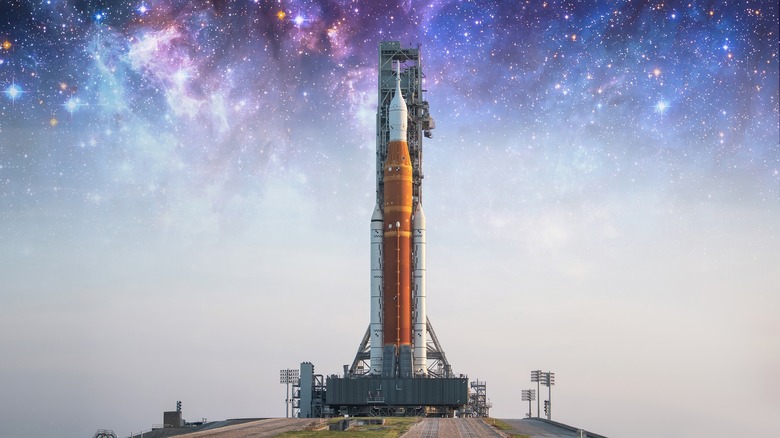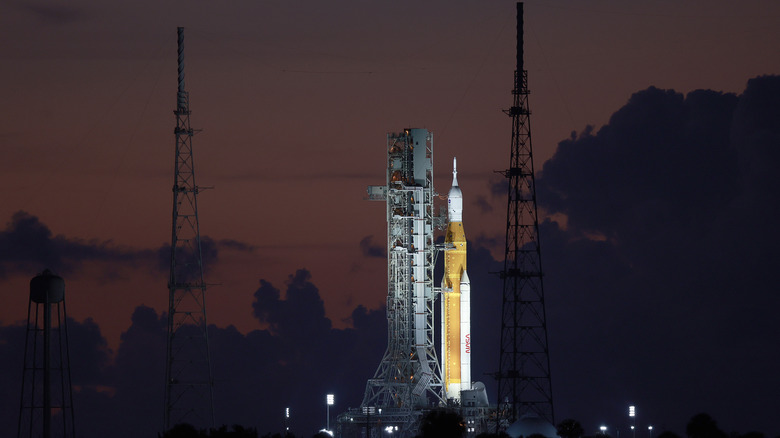The Reason Why NASA's Artemis Program Doesn't Have Reusable Rockets
NASA has been busy over the last few years. The Artemis Program — a reboot of the original Apollo missions to reach the Moon's surface — has been a highlight of the news cycle in recent weeks. Initially announced in December 2017, the Artemis Program aims to establish a presence on the Moon in an effort to eventually reach Mars with ease (via NASA).
The Artemis rockets have a different look, continuing the trend of disusing the space shuttle model, and opting for a staged rocket that's a throwback to both the Apollo days in spirit of mission and visual feel.
Some people may be wondering why NASA has chosen to make use of single use rockets once again. Staged rockets look phenomenal, but they are substantially more expensive and are designed to incorporate boosters that fall away and a complete package that becomes debris after the mission capsule is detached for crew descent back to Earth.
The truth is the rocket design lies in a few mission critical considerations (via Republic World and Astronomy). NASA engineers are some of the brightest problem solvers on the planet, but this one comes down to simple physics, mission necessity, and astronaut safety.
The space shuttle was always a problematic means of reaching the stars
One of the main reasons for the single-use rockets that will dominate the Artemis Project is the set of core issues that plagued the space shuttle program. While shuttles provided a multi-use platform to haul payloads and crews up to space, the aircrafts themselves suffered from a general lack of safety, according to Newsweek. After the Challenger explosion in 1986, there was a real concern with the shuttles' launch faculties, and the 2003 burnout of the Columbia upon atmospheric reentry really put the nail in the coffin. Shuttle launches were used sparingly from then until the program was eventually shut down in 2011.
In addition to the safety issues on both the launch sequence and reentry procedures, the cost of these reusable rockets actually far exceeded expectations (via Newsweek), making the shuttle blueprint something that remained wanting in many more ways than one.
Likewise, the shuttles that NASA used during the program's run were woefully underutilized relative to their flight ratings, ratcheting up the overall relative expenditure of this mission sequence in the end result. Astronomy notes that shuttles were designed for quick turnarounds, facilitating expansive exploration of low-Earth orbit. However, the turnaround times for concurrent launches was far slower than anticipated, forcing the NASA team to shelve dreams of cosmic grandeur that the shuttle program once signaled.
Stage rockets are mission-specific for launching small teams with precision
What's also telling about the shuttle's decommissioning in 2011 is the context. Space shuttle launches were difficult to coordinate because of the logistics of the aircraft, but they were warranted at the time because the International Space Station was being built, requiring manpower and materials that a single use rocket simply couldn't accommodate (via Astronomy).
The shuttle was built to launch into orbit and then remain there for study and provisioning of the ISS. But travel beyond Earth's orbit requires more firepower in the front end to escape the gravity of the planet, and a different trajectory and fuel calculation to ensure safe return at the end of the mission. Simply put, multi-staged rockets are purpose-built for a successful Moon landing and travel farther beyond our terrestrial proximity (via NASA).
As well, the question of Moon exploration isn't just about getting there. Multi-stage rockets that can essentially throw a return capsule into the proper trajectory are far more adept at completing the mission here than a shuttle would be, according to Astronomy — even as the space shuttle more closely mirrors sci-fi projections of crewed space flight than the escape pod-type landing vehicles that astronauts rely on.
At the end of the day, the Artemis rockets are the perfect vehicle for safely arriving at the moon and expanding the horizon of human possibility ever farther.


